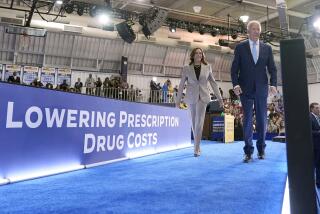Brand-Name Drug Prices Up 7.1% in ‘04, Study Says
- Share via
Brand-name prescription drug prices rose 7.1% in the U.S. last year, more than twice the pace of inflation, while generic drug costs were little changed, according to the AARP.
The gain translates into an additional $154.68 a year for a typical American older than 50 who takes three prescription medicines, said Washington-based AARP, the consumer group that represents more than 35 million Americans age 50 and older. The added expense is based on the average cost for three brand-name drugs.
AARP said it releases the quarterly reports to pressure manufacturers into holding down costs. The group also supports measures such as legalizing imports of cheaper drugs. The average increase in brand-name drugs was the U.S.’ biggest on an annual basis in five years. The general inflation rate was 2.7%.
Wyeth’s 26% increase on its Premarin menopause treatment was the biggest price jump by percentage for a single drug, followed by Novartis’ 22.3% boost for the cost of Miacalcin, used to treat the bone-thinning disease osteoporosis, the report said.
Wyeth spokesman Chris Garland attributed the increase in part to the company’s spending on research and development of medicines for women. He said those expenses didn’t decline when a National Institutes of Health study of Premarin was halted in February 2004 because of findings that the hormone drug may increase patients’ risk of stroke.
“We’re committed to research in women’s health, plus demand for Premarin is increasing,” Garland said.
The Pharmaceutical Research and Manufacturers of America, which represents drug makers including Wyeth and Novartis, said prescription drug inflation had increased at a similar rate to overall medical inflation.
From January 2000 through February 2005, drug prices rose at an annual rate of 4.1%, compared with medical inflation of 4.4%, the group said, citing government data.
“The U.S. government’s publicly available consumer-price data for that period clearly show that prescription-drug prices increased at a slower rate than overall medical care,” the industry group said in a statement. “We are working to help patients in need get medicines through the new Partnership for Prescription Assistance,” which was announced last week.
AARP studied prices that manufacturers charged wholesalers such as McKesson Corp. for 195 brand-name prescription drugs commonly used by older Americans. AARP’s Public Policy Institute wrote the report with University of Minnesota professor Stephen Schondelmeyer, who studies pharmaceutical economics.
Hormone therapy for women saw the highest average annual increase, 12.9%, followed by diabetes drugs at 12.3%.
More to Read
Inside the business of entertainment
The Wide Shot brings you news, analysis and insights on everything from streaming wars to production — and what it all means for the future.
You may occasionally receive promotional content from the Los Angeles Times.










